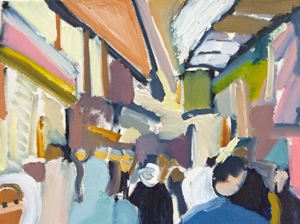Colors as sounds, and signs as colors
AUT 2011: Neurodiversity to be held at Museum of Modern Art until May 7
In its last issue The Day informed its readers that recently the Museum of Modern Art, in cooperation with the Art Association Doroshenko & Hryshchenko Clinic, presented the international art project AUT 2011: Neurodiversity, which aims to “reveal” the special world of autistic people.
[…]There is a growing number of people diagnosed with autism. This has sparked an attempt to identify and associate autism with outstanding people (like Albert Einstein or Thomas Jefferson) and to define it as a possible manifestation of neurodiversity.
A young man with Asperger syndrome who attended a neurology institute was asked what he would do if there was a medication for autism. He thought a little and replied that he would take half a pill. This decision reflects the ambiguity within the autistic community.
Some hide their condition, isolating their families in an environment where their “difference” can’t be noticed: in private schools or studying at home and later choosing a profession with minimal social interaction. Others consider this “neurodiversity” as a civil rights movement, against “neurofanaticism” and “neurotypical’s rights.”
About one of ten autistic people has particular talents that set them apart, like extraordinary memory or art skills. Naturally, not everybody suffering from synesthesia, autistic range or Asperger syndrome has a talent for art [...]
(medicine), tutor of the project
AUT 2011: Neurodiversity
[…] A lot can be explained through the modern theory of neurodiversity, which insists on cross censor links present in certain parts of the brain that significantly influence our emotional perception and experience.
One of the bright examples of the extraordinary psycho-emotional phenomena that can be explained today through the neurodiversity theory is synesthesia, the natural ability to perceive colors as sounds, and signs (words, names, numbers, etc) as colors.
In the arts synesthesia became popular at the turn of the 19th and 20th centuries: for example, the French symbolists Paul Verlaine, Arthur Rimbaud and Charles Baudelaire wrote sonnets about sounds and colors, the Russian composer Alexandr Scryabin came up with the idea to create a “synesthetic” art in which certain musical sounds corresponded to certain colors; later this idea became the basis for the creation and popularization of the famed “son et lumiere.”
Quite a lot of writers and artists are considered synesthetics, notably Wassily Kandinsky […]
Originality is revealed in the individual distinctions — in something different and unique. The different is the diversity’s flesh, which is why the odysseys that set out to look for it are so important. They are “humanauts,” charmed Don Quixotes wondering with a lantern in their hearts to find nothing else but themselves. On this path the people are territories, mysterious yet constantly expanding with new lands, mountains and forests. That is why this journey is so exciting as everyone is a universe with millions of roads. When we open up the way we are the world will become a neurodiverse community, an atomic rainbow opening the door to uniqueness […]
Newspaper output №:
№24, (2011)Section
Time Out





